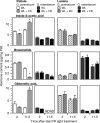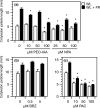Organ-specific phytohormone synthesis in two Geranium species with antithetical responses to far-red light enrichment
- PMID: 31245741
- PMCID: PMC6508794
- DOI: 10.1002/pld3.66
Organ-specific phytohormone synthesis in two Geranium species with antithetical responses to far-red light enrichment
Abstract
Plants growing in high densities experience a reduced red (R) to far-red (FR) light ratio and shade-intolerant species respond with accelerated elongation growth to reach the top of the canopy: the shade avoidance syndrome (SAS). FR-enriched light inactivates phytochrome photoreceptors, which results in subsequent action of several plant hormones regulating growth. SAS is adaptive for shade-intolerant plants, but is suppressed in shade-tolerant plant species. Inspired by a previously published transcriptome analysis, we use two species of the genus Geranium here to study the involvement of auxin, brassinosteroids (BRs), and gibberellins (GAs) in supplemental FR-induced elongation growth. G. pyrenaicum, a shade-avoiding species, strongly induces auxin and gibberellin levels, but not BR, in elongating petioles. We show that, in this species, FR light perception, hormone synthesis, and growth are local and restricted to the petiole, and not the leaf lamina. Using chemical hormone inhibitors, we confirm the essential role of auxin and GAs in supplemental FR-induced elongation growth. Shade-tolerant G. robertianum does not display the change in hormone levels upon FR light enrichment, resulting in the lack of a shade avoidance response.
Keywords: Geranium; auxin; brassinosteroids; gibberellins; phytochrome signaling; shade avoidance.
Figures








Similar articles
-
Involvement of auxin and brassinosteroid in the regulation of petiole elongation under the shade.Plant Physiol. 2010 Aug;153(4):1608-18. doi: 10.1104/pp.110.156802. Epub 2010 Jun 10. Plant Physiol. 2010. PMID: 20538889 Free PMC article.
-
Progress of Research on the Regulatory Pathway of the Plant Shade-Avoidance Syndrome.Front Plant Sci. 2020 Apr 15;11:439. doi: 10.3389/fpls.2020.00439. eCollection 2020. Front Plant Sci. 2020. PMID: 32351535 Free PMC article. Review.
-
Hormonal Regulation in Shade Avoidance.Front Plant Sci. 2017 Sep 4;8:1527. doi: 10.3389/fpls.2017.01527. eCollection 2017. Front Plant Sci. 2017. PMID: 28928761 Free PMC article. Review.
-
Auxin and ethylene regulate elongation responses to neighbor proximity signals independent of gibberellin and della proteins in Arabidopsis.Plant Physiol. 2009 Apr;149(4):1701-12. doi: 10.1104/pp.108.133496. Epub 2009 Feb 11. Plant Physiol. 2009. PMID: 19211699 Free PMC article.
-
YUCCA auxin biosynthetic genes are required for Arabidopsis shade avoidance.PeerJ. 2016 Oct 13;4:e2574. doi: 10.7717/peerj.2574. eCollection 2016. PeerJ. 2016. PMID: 27761349 Free PMC article.
Cited by
-
Light signalling shapes plant-plant interactions in dense canopies.Plant Cell Environ. 2021 Apr;44(4):1014-1029. doi: 10.1111/pce.13912. Epub 2020 Oct 22. Plant Cell Environ. 2021. PMID: 33047350 Free PMC article. Review.
-
Photoreceptor Activity Contributes to Contrasting Responses to Shade in Cardamine and Arabidopsis Seedlings.Plant Cell. 2019 Nov;31(11):2649-2663. doi: 10.1105/tpc.19.00275. Epub 2019 Sep 17. Plant Cell. 2019. PMID: 31530733 Free PMC article.
-
Conservation and Diversity in Gibberellin-Mediated Transcriptional Responses Among Host Plants Forming Distinct Arbuscular Mycorrhizal Morphotypes.Front Plant Sci. 2021 Dec 16;12:795695. doi: 10.3389/fpls.2021.795695. eCollection 2021. Front Plant Sci. 2021. PMID: 34975984 Free PMC article.
-
Canopy Light Quality Modulates Stress Responses in Plants.iScience. 2019 Dec 20;22:441-452. doi: 10.1016/j.isci.2019.11.035. Epub 2019 Nov 25. iScience. 2019. PMID: 31816531 Free PMC article. Review.
-
Auxin-Dependent Cell Elongation During the Shade Avoidance Response.Front Plant Sci. 2019 Jul 12;10:914. doi: 10.3389/fpls.2019.00914. eCollection 2019. Front Plant Sci. 2019. PMID: 31354778 Free PMC article. Review.
References
-
- Bou‐Torrent, J. , Galstyan, A. , Gallemí, M. , Cifuentes‐Esquivel, N. , Molina‐Contreras, M. J. , Salla‐Martret, M. , … Martínez‐García, J. F. (2014). Plant proximity perception dynamically modulates hormone levels and sensitivity in Arabidopsis. Journal of Experimental Botany, 65, 2937–2947. 10.1093/jxb/eru083 - DOI - PMC - PubMed
-
- Cifuentes‐Esquivel, N. , Bou‐Torrent, J. , Galstyan, A. , Gallemí, M. , Sessa, G. , Salla Martret, M. , … Martínez‐García, J. F. (2013). The bHLH proteins BEE and BIM positively modulate the shade avoidance syndrome in Arabidopsis seedlings. The Plant Journal, 75, 989–1002. 10.1111/tpj.12264 - DOI - PubMed
LinkOut - more resources
Full Text Sources

